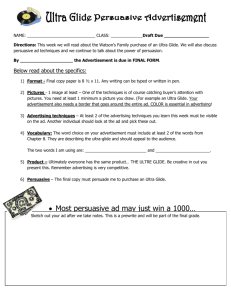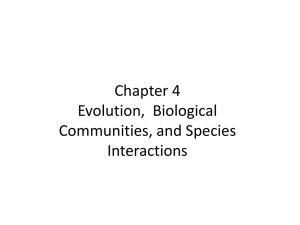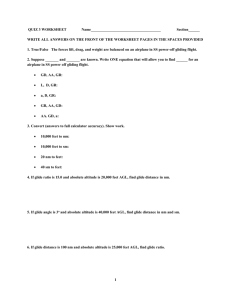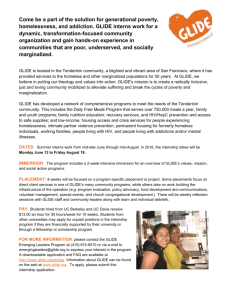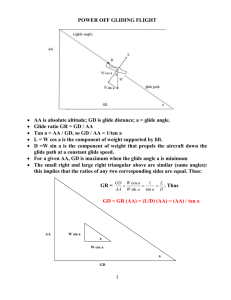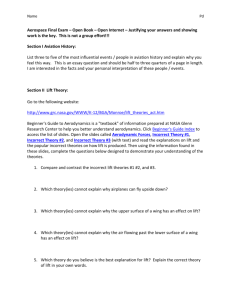Training - Paper Airplanes
advertisement
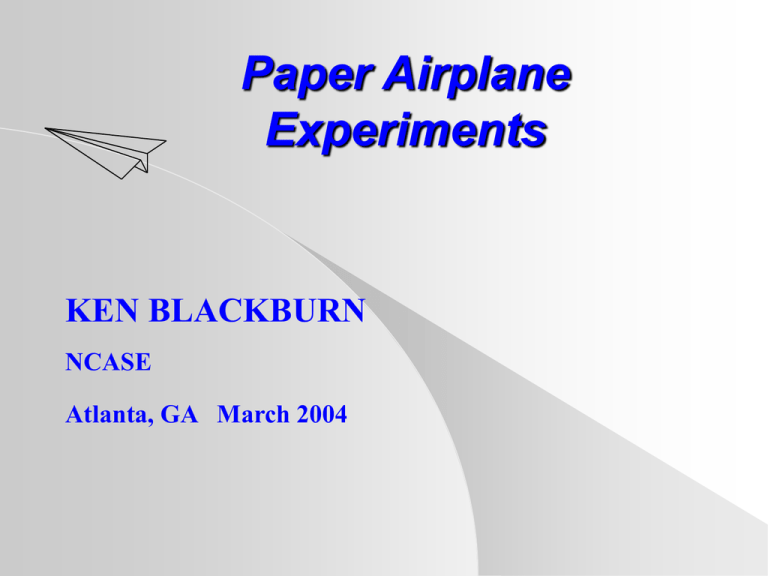
Paper Airplane Experiments KEN BLACKBURN NCASE Atlanta, GA March 2004 Presentation Overview Uses of paper airplane experiments Types of experiments Examples – Ball vs. airplane – Wind tunnel – Glide tests Uses for Experiments Classroom – Visually explain principles of flight – Addresses many requires standards National, State Scientific Inquiry, motion & forces, properties & measurement Science Fair Projects Youth group (scouting…) activities Team Building Fun!!!!! Types of Experiments Lift – Glide test – paper airplane vs. the paper ball – Wind tunnel – effect of wing area, airspeed, and wing angle Drag – Drop test – paper parachute vs. paper ball – Effect of wingspan on drag – Glide tests to compare drag of different paper airplane designs Stability – Effect of paper clip location on flight stability Glide Test – Airplane vs. Ball Principle demonstrated: Lift (force, test) Procedure – Take 2 sheets of paper – make a paper plane and a paper ball – Give them a gentile toss straight forward, one in the right hand, one in the left Results – The ball hits the ground first. Why? The paper airplane has wings which create lift to slow its fall to the ground. Wind Tunnel – Air Flow Principle demonstrated: Conservation of mass, pressure Procedure: Construct wing tunnel, Use incense to show air flow into, through, and out of tunnel Results: How does the wind tunnel work? Where does the air flow fastest, at the narrow or wide end of the tunnel? Wind Tunnel Construction Materials: 20” square box fan (Wal-Mart), four 22”x28” poster boards, two 36”x1/4” dowel rods, duct tape Procedure: Cut out poster board sides, duct tape together, cut dowel rods into 14” lengths and tape around entrance, curl 2” narrow ends and tape for smooth airflow. Balance: Wood yardstick and 2”x2” wood frame can make see-saw balance with letter scale. Air flow can be measured with Radio Shack pocket wind gauge (I measured 10 mph). Wind Tunnel – Lift Principle demonstrated: Lift (force, test, measurement) Hypothesis: Lift increases as a wing is angled nose up Procedure: Measure vertical force – measure with wings set nose up at 0, 5, 10, 15, 20, 25, 30 degrees Results: Lift increases with angle of wing 25 Lift - grams 20 Measured 15 10 Theory 5 0 -5 0 5 10 15 20 -10 Wing Angle - Deg 25 30 35 Distance/Height Glide Test – Elevator Principle demonstrated: Drag (force, test, measurement) Hypothesis: The best glide distance is achieved with a particular elevator setting that sets the best glide wing angle Procedure: Measure glide distance (angle) for increasing elevator settings Results: Maximum glide distance is achieved at a particular elevator setting, reduced distance for less elevator angle, constant to reduced glide distance for more elevator angle 7 6 5 4 3 2 1 0 0 0.1 0.2 0.3 0.4 0.5 Increasing Elevator Setting 0.6 Glide Test – Span Principle demonstrated: Drag (force, test, measurement) Hypothesis: Drag decreases and glide distance increases with increasing wing span Procedure: Measure steady glide distance. Make 3 or more paper airplanes of the same design, each with the wings folded out to a different span. Adjust elevator of each for best glide distance. Plot glide distance divided by initial height for each. Results: Longer wingspan results in greater glide distance, therefore has reduced drag compared to shorter span. Glide Angle length/height 7 6 5 4 3 Theory Experiment 2 1 SPAN 2” 0 0 2 4 6 Span - in 8 10 4” 6” 8” Internet Resources: My educational information http://paperplane.org/resource.html Smithsonian Air & Space Museum http://www.nasm.si.edu/exhibitions/gal109/gal109.html NASA GLENN Research Center http://www.grc.nasa.gov/Doc/educatn.htm
